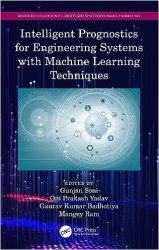Intelligent Prognostics for Engineering Systems with Machine Learning Techniques
- Добавил: literator
- Дата: 5-08-2023, 18:16
- Комментариев: 0
 Название: Intelligent Prognostics for Engineering Systems with Machine Learning Techniques
Название: Intelligent Prognostics for Engineering Systems with Machine Learning TechniquesАвтор: Gunjan Soni, Om Prakash Yadav, Gaurav Kumar Badhotiya, Mangey Ram
Издательство: CRC Press
Год: 2024
Страниц: 261
Язык: английский
Формат: pdf (true)
Размер: 66.2 MB
The text discusses the latest data-driven, physics-based, and hybrid approaches employed in each stage of industrial prognostics and reliability estimation. It will be a useful text for senior undergraduate, graduate students, and academic researchers in areas such as industrial and production engineering, electrical engineering, and Computer Science. The book The text deals with tools and techniques used to predict/ extrapolate/ forecast the process behavior, based on current health state assessment and future operating conditions with the help of Machine Learning (ML). It will serve as a useful reference text for senior undergraduate, graduate students, and academic researchers in areas such as industrial and production engineering, manufacturing science, electrical engineering, and Computer Science.
Deep Learning (DL) is a subset of ML that involves a multi-layered artificial neural network (ANN). The working of ANN is inspired by how the nervous system of the human brain functions. A basic ANN consists of input, output, and hidden layers. Each layer consists of neurons, which resemble brain cells. A mathematical representation of the biological neuron is termed as “perceptron,” and thus, multi-layered neural network is also referred to as multi-layer perceptron (MLP) model. The hidden layer develops interconnections between the neurons to establish a relation between the input feature and output class. An ANN with more than one hidden layer is termed a “deep neural network (DNN).” We will now look at two different DNNs and their applications in bearing fault detection. First is a convolutional neural network (CNN), a DL method that primarily uses images as input. CNN converts a raw image into a feature vector through different operations. A layered neural network architecture then processes the feature vector to classify the image into a particular class. Recurrent neural network (RNN) is another DL algorithm that has gained popularity owing to its capacity in processing sequential data. This property makes it an essential model for solving problems where the data is time instance based. Fundamentally, RNN is a neural network consisting of multiple layers where the information flows in a cyclic loop.
Скачать Intelligent Prognostics for Engineering Systems with Machine Learning Techniques
[related-news] [/related-news]
Внимание
Уважаемый посетитель, Вы зашли на сайт как незарегистрированный пользователь.
Мы рекомендуем Вам зарегистрироваться либо войти на сайт под своим именем.
Уважаемый посетитель, Вы зашли на сайт как незарегистрированный пользователь.
Мы рекомендуем Вам зарегистрироваться либо войти на сайт под своим именем.
